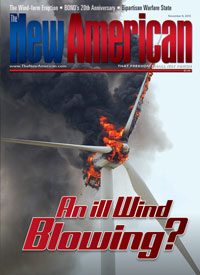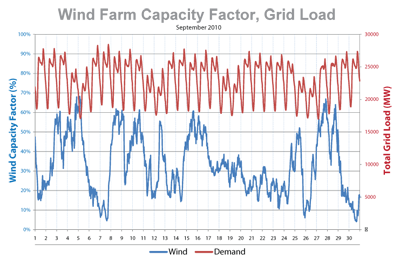
According to the 2009 Energy Information Agency Report on Electricity Generation, wind power provided 70.8 billion kilowatt hours (kWh) out of the U.S. total of 3,953 billion kWh. Why, it must be asked, does wind power equal only 1.79 percent of the generated power when over the past 30 years seemingly every political speech has contained the phrase “wind, solar, or other renewables” as the solution to our energy problems?
Then, too, while wind power has been pushed by politicians and environmentalists, new construction of coal-fired plants has been opposed to the extent that net energy production from coal in 2009 was below that of 1996, and no new nuclear plants have been allowed to proceed from the drawing board since the 1979 accident at Three Mile Island, indicating that an energy void was waiting to be filled by some power source. Cleaner burning but more expensive natural gas has made up the difference, not wind and solar energy.
As we all know, fuel for wind turbine generators is free, so why don’t the tight-fisted executives at electrical generating companies insist that the percentage of wind power be brought up to at least 10 percent, if not 20 or 30 percent? One contention is that utility executives are in bed with fuel suppliers and reject wind energy out-of-hand. However, before saddling the operators of generating companies with that condemnation, let us take a look at wind energy from their perspective.
Wind Energy in the Business Plan
To see wind energy through the eyes of electricity producers, it is important to know one basic fact about electricity generation, whether it be the generator in your car or the output of Palo Verde nuclear complex: Electricity must be used at the instant of generation. When you turn on a light switch, somewhere on the electrical network a generator is loaded and slows down. At generating plants, an automatic device senses the added load and increases the temperature of the steam in the boiler to bring the frequency back to its set point. When you turn off a light, the temperature is automatically reduced, and the frequency returns to the desired value. This is known as negative feedback and is like “cruise control” on your car.
Electric utilities have a variety of generators on a network. The workhorses are large coal-fired and nuclear plants that are designed to run at peak load constantly. Some nuclear plants have run at full power for over a year — the record for continuous power production is 512 days, held by Watts Bar 1 in Tennessee. These plants are used for base load, i.e., the load on the system that is there day and night, caused by homes’ hot water heaters, heating and cooling systems, street lights, hospitals, 24-hour industries, water and sewage systems, airports, etc. It would make no sense to use wind power for these loads for a number of reasons, but primarily because wind power is not dispatchable upon demand.
Power suppliers must contend with fluctuating power demands, both daily and seasonal changes. At 5:30 a.m. alarm clocks start ringing, coffee pots start up, along with hot water heaters for showers. Restaurants fire up toasters, and factories come up to speed for a day of production. Grid operators expect this to happen and, based on hour of day, time of year, and day of week, bring on additional generating assets, such as small coal plants, combined-cycle gas, and — if lucky enough to have them — hydroelectric or pumped-storage generation. This is known as the diurnal cycle, and the generators called on to meet the varying demand are known as demand followers. Can wind power be scheduled by operators to follow the daily variations in demand? Hardly. Not only must operators respond to a variable demand from customers but, in the case of wind power, must do so with a variable supply, thus bringing a new unknown into the equation.
Fortunately for grid operators (and those of us that expect power when we turn on the light switch), power supplied to the grid can usually be closely modulated by the various dependable sources, but not always. For the grid operator, terror strikes when one of his generating plants suddenly goes offline or when, on a particularly hot July afternoon, the system demand is obviously headed past maximum generation capacity. In these cases of peak loads, when demand exceeds the available supply of electricity, a whole lot of unhappy things happen. Frequency and voltage drop, while currents in power lines increase, requiring automatic or manual interruption of loads — blackouts — to protect the grid. To deal with this, “spinning reserves,” power plants that have spinning generators but are not loaded, are brought instantly online. Gas turbines — essentially jet plane engines connected to a generator — are also able to add generating capacity in a very short time.
various dependable sources, but not always. For the grid operator, terror strikes when one of his generating plants suddenly goes offline or when, on a particularly hot July afternoon, the system demand is obviously headed past maximum generation capacity. In these cases of peak loads, when demand exceeds the available supply of electricity, a whole lot of unhappy things happen. Frequency and voltage drop, while currents in power lines increase, requiring automatic or manual interruption of loads — blackouts — to protect the grid. To deal with this, “spinning reserves,” power plants that have spinning generators but are not loaded, are brought instantly online. Gas turbines — essentially jet plane engines connected to a generator — are also able to add generating capacity in a very short time.
Where’s wind power? Is it even available? Maybe, maybe not. Because the operator cannot reliably call it up when needed, it is certainly not useful for peak loads.
If wind power does not meet requirements for base loads, is not dispatchable for load following, and cannot be called up to answer spikes in peak loading, where does wind power fit into the business plan? Assuming the preceding analysis is correct (and it is), wind has no place in energy production from an operational standpoint. As Jon Boone (www.stopillwind.org) so tersely puts it: “In terms of reliable, secure, affordable electricity, wind performs best when it produces nothing.”
It’s Always Blowing Somewhere
Utility executives would no doubt be concerned with wind power’s variability and lack of reliability, and wind industry lobbyists would assuredly attempt to allay executives’ fears with the standard answer: “Yes, you may find times when local conditions are such that sufficient wind is not available, but as the network of wind farms and projects is tied together in a ‘smart grid,’ you will be able to draw on wind resources from other areas thus ‘smoothing out’ your wind power supply.”
As they say, “It sounds good in theory.” Perhaps we could look around the world and see if this holds true.

Fortunately, there is such a place to provide us an example. In Southeast Australia, there are 18 wind “projects” or “farms” interconnected within an area covering 40,000 square miles. Roughly, this would equate to an area in the United States bounded by Des Moines, east to Philadelphia, south to Charleston, South Carolina, and west to a location just south of Tulsa. Certainly most of us would consider 40,000 square miles sufficient for wind power to “average out.” The Australian projects have the added benefit that they are all built near the coast where the winds are stronger and more constant than in the outlined area in the United States. But the graph here, which provides actual output data from hundreds of wind turbines, shows this to be another wind fiction.
Fuel and Emissions Savings
Unable to find a place for wind in electricity generation, proponents change to their pseudo-environmental hats: “You can’t deny that when wind energy is producing power, we are saving fossil fuels that otherwise would be being used.” It is a persuasive argument and correct if considering an isolated system. But it is a wrong one when speaking of industrial electricity generation.
Let us assume that a stand-alone windmill turning a pump runs for an hour and delivers 1 kW of power for 15 minutes, 2 kW for 15 minutes, zero for 15 minutes, and 1 kW for the last 15 minutes. One kWh of energy was used by the pump, and was delivered via wind power. If the pump were instead connected to an electrical outlet, we would have used enough fuel to provide 1 kW of power for one hour, or 1 kWh. Obviously, the windmill here would save on whatever fuel was fueling the generation.
But the wind turbines that are foisted upon our utilities by lobbyists, environmentalists, and politicians do not operate in what might be considered a generating vacuum. They operate in a network of other generating equipment where a change in the output of one device has an effect on the operation of another.
Let us take an imaginary power grid that has 100 megawatts (MW) of coal-fired generating power and 10 MW of wind power. Let us further suppose that there is a constant demand on the system of 50 MW — of which 45 MW is provided by coal, and 5 MW from wind turbines. If the wind component increases to 10 MW, requiring the temperature in the fossil-fired boiler to drop by say 10?F in order to maintain the equality of demand and supply, energy must be shed as waste heat in cooling the boiler. Thus when wind power to the system increases, the energy in the boiler must be wasted, else the balance of generation and usage would be disrupted causing the network frequency to rise.
But then when the wind component decreases, the boiler must increase its temperature to the point where it is now handling the demand. On the way to this point, energy is added to the system without doing any work: The boiler is merely “heating up” to the point that generation occurs. Thus any time the wind component varies (and it is constantly varying), there is wasted energy in the operation of the primary generating source.
In practice, the base load is rarely affected by wind, but the boilers in the power plants functioning as spinning reserves (“spinning standbys” in the U.K.) don’t stop consuming fuel while the wind generation is occurring. To be responsive to wind speed increases or decreases, the boilers must maintain a temperature very near that required for production should they be called upon to respond instantaneously to changes in the wind component.
Those generators paired with wind generation experience inefficiencies that are related to wind volatility (the bigger the swings, the worse the effect) and the percentage of wind on the grid (the higher the wind percentage, the greater the inefficiencies). When the wind-power component equals one percent or so of a grid’s power, studies show there are little or no savings of fossil fuel, but when wind power is over two or three percent, there may be an increase in fuel usage and CO2 emissions — the raison d’être for wind power in the first place.*
Looking at the Long Term
Utilities executives, whose job it is to make sure that customers have a reliable, economical source of electric power, would likely want to deeply explore the benefits  versus drawbacks of wind generation, and so far it doesn’t look good. Wind power certainly does not fit into normal generation plans, and the savings of fossil fuels is largely a myth. Moreover, even if a plethora of wind farms are tied together, the vagaries of the weather insure times of insufficient wind; therefore, all current generating assets must be kept available. In fact, the assets need to be consuming thermal energy, ready, rotating, and costing the utility and/or its customers money without doing any useful work, i.e., generating electricity.
versus drawbacks of wind generation, and so far it doesn’t look good. Wind power certainly does not fit into normal generation plans, and the savings of fossil fuels is largely a myth. Moreover, even if a plethora of wind farms are tied together, the vagaries of the weather insure times of insufficient wind; therefore, all current generating assets must be kept available. In fact, the assets need to be consuming thermal energy, ready, rotating, and costing the utility and/or its customers money without doing any useful work, i.e., generating electricity.
There is another factor that should be considered: maintainability. How will the flood of turbines currently being installed hold up over time? For comparison, remember that many of our 104 nuclear plants are nearing their 40-year expected lifetimes, but thanks to careful engineering and maintenance are being extended for another 20 years of operation, often at a higher than originally designed MW output level.
A modern wind-turbine generator is a highly complex device that is much more than three blades connected to a generator. There are motors to adjust the pitch of the blades to maximize the wind-to-shaft efficiency — and to stop rotation in high winds to avoid damaging the turbines. There is an anemometer on top that directs a motor to turn the blades into the wind, a large bearing to hold the weight of the blades and resist the many other forces on it (such as the gyroscopic force encountered when turning the nacelle), and a transmission to increase the speed of the drive shaft from a few rpm to 1,800 rpm. It also has a variety of electrical controls to synchronize the output frequency to within microseconds of the grid frequency, monitor subsystems, and communicate this information to wind-farm operations. Knowing that mechanical systems do experience wear, and must be maintained and eventually replaced, what does this bode for wind turbines?
A report sponsored by the National Renewable Energy Laboratory† — not exactly a regular skeptic of wind power — contained the following statement:
Despite reasonable adherence to these accepted design practices, wind turbine gearboxes have yet to achieve their design life goals of twenty years, with most systems requiring significant repair or overhaul well before the intended life is reached.
Ouch! Since the cost of wind energy is largely due to the high cost of wind turbines, wouldn’t that increase the already-high price paid for wind power? From the same report:
Since gearboxes are one of the most expensive components of the wind turbine system, the higher-than-expected failure rates are adding to the cost of wind energy. In addition, the future uncertainty of gearbox life expectancy is contributing to wind turbine price escalation. Turbine manufacturers add large contingencies to the sales price to cover the warranty risk due to the possibility of premature gearbox failures.
But that’s only one source. Perhaps the wind promoters in government are being uncharacteristically negative. How about a Durham University School of Engineering report‡ looking to promote off-shore wind generation. These were the concluding points regarding the state of wind-turbine reliability:
1. Unreliability: Greater than one failure per turbine per year is common.
2. Unreliability is higher for larger turbines.
3. Such unreliability will be unacceptable offshore, we need reliability of less than 0.5 failures per year per turbine.
Fixing a broken wind-turbine gear box isn’t as simple as strapping on a tool belt and turning wrenches for a couple of hours. Perhaps you have seen the scary sight of your car’s engine being pulled out of the engine compartment by an overhead crane in a repair shop. There are hoses and wires and belts and tubing poking everywhere. It is maneuvered over to a bench where the mechanics perform mysterious operations, and then the overhead crane plucks it up and returns it back into the car. In a few hours you’re on your way with a considerably lighter wallet.
Now imagine that it is not your car sitting on terra firma, but a nacelle with blades together weighing 92 tons, perched 25 stories in the air so that a crane longer than a football field must be brought in, in many cases over mountain roads, to pick up the gearbox or generator and bring it to earth. The mechanic in this case isn’t leaning over your fender, but has had to climb 25 stories on a ladder — not a staircase, elevator, or man-lift — straight up hand-over-hand with precious few places to rest on the way up (or down).
It gets even worse when doing maintenance or replacement of rotors, clinging to the nacelle while directing the crane operator as to where to put the hook.
Oh, did we mention the transformers and miles of underground 25,000- to 30,000-volt electric cables connecting the wind turbines to the collection transformer?
Rephrasing the Question
Given the ample drawbacks to wind generation for utility companies and the paucity of benefits, maybe we should change the question to: “Why would any utility executive be in favor of wind energy being anywhere on his or her radar?”
Two reasons are evident. First, there are some left-wing, environmentalist activists in charge of large utility companies. “Cap and Tax” supporter Peter Darbee, president of Pacific Gas and Electric, comes immediately to mind. (But he is likely an exception to the rule.)
Second, most executives want to keep their companies profitable and stay out of jail, though not necessarily in that order. Enter the Renewable Portfolio Standard (RPS), which requires utility companies to produce a certain percentage of “renewable” energy output. Lawmakers, many of whom don’t know a volt from a pineapple, have taken it upon themselves to require those who have provided energy to their customers for many decades to change their wicked ways and embrace wind energy — to please the wind lobby and the radicals in our government. Unfortunately, it is within their power to do so, temporarily. The manipulations can only continue for so long before the energy chickens come home to roost.
Politicians, their scientific lackeys, and environmental activists can lie, and people can be taken in by smooth-sounding prop-aganda about “free energy” and “green jobs.” But eventually the laws of physics will show that charlatans have hoodwinked a country into wasting its capital on structures that one day will be toppled like the statue of Saddam Hussein: torn down in protest of government manipulation and deceit.
— Photo: Polizeiinspektion Stade
* Interested readers should download “The Ultimate Irony” by Kent Hawkins, available from http://scienceandpublicpolicy.org/reprint/subsidizing_co2.html
† Contract No. DE-AC36-99GO10337 to Midwest Research Institute
‡ Durham University School of Engineering, “The Reliability of Different Wind Turbine Concepts, with Relevance to Offshore Applications.”
Related article:



